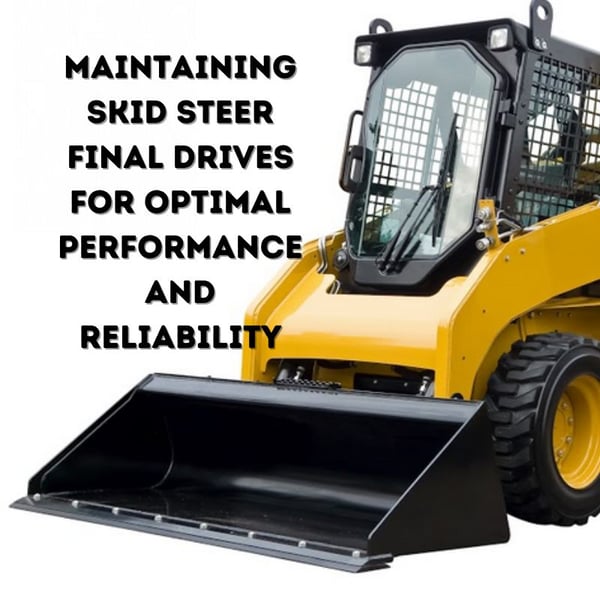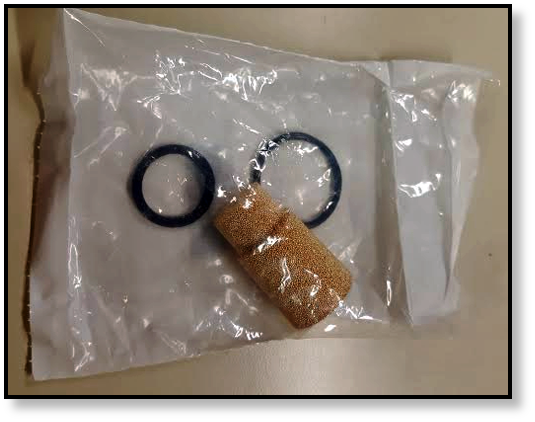We know that it’s vital to keep your skid steers rolling year-round and that the key to their reliability and performance lies in maintenance.

In this Shop Talk blog post, we’ll discuss the key maintenance tasks for skid steer final drives that will increase their uptime, reduce repair costs, and extend their lifespan.
Here are some additional blog posts you might be interested in:
- Catastrophic Failure: Why Gear Oil Maintenance is So Important
- Demystifying Skid Steer Loader Categories
- 5 Common Questions about Skid Steer Loaders
Gear Oil Maintenance for Skid Steer Loaders
Gear oil maintenance includes checking the gear oil levels and changing the gear oil. How often you check the gear oil levels you're skid steer final drives depends on three main factors:
- Manufacturer recommendations: Always check your owner's manual first. This will be the most accurate and specific information for your skid steer model. It will likely specify the recommended frequency for checking and changing the gear oil.
- Operating conditions: If you operate your skid steer in harsh conditions such as dusty environments, extreme temperatures, or rough terrain, you may need to check the gear oil more frequently.
- Usage frequency: If you use your skid steer heavily, you may need to check the gear oil more often than someone who uses it infrequently.
Here’s a good rule of thumb:
- Minimum: Most manufacturers recommend checking the gear oil level at least every 100 hours.
- More frequent: You need to check every 25 - 50 hours in harsh conditions or heavy usage.
We’ve got a blog post describing the process: Checking and Changing the Gear Oil in Your Final Drive. However, what follows is an updated description.
Here’s how to check your gear oil levels:
First, some prep. Park your skid steer on level ground and run it enough for the gear oil to heat up.
- When you look at the cover plate of your travel motor, you’ll notice two or possibly 3 plugs. Arrange your final drive so that one plug is at the 12 o’clock position and the other is either at the 3 o’clock or 9 o’clock position.
- Clean out any debris, dirt, mud, sand, soil, etc., from around the plugs to minimize the chances of contamination.
- Loosen the two plugs -- you may need to hit them with a hammer to loosen them. Then remove the.
- Take a moment to check the inside of the plugs for signs of internally generated contamination. Look for slivers and particles of metal--if you see them, you need to get your drive motor checked out.
- If there’s enough oil, the oil will be level with the bottom opening, with just a small amount draining out.
- If the oil is low, add it through the upper until it begins to run out the lower opening.
- Once you have finished topping off the gear oil, replace the upper plug.
How often you change out your gear oil is tricky. It does need to be changed out regularly, otherwise, you are inviting a catastrophic failure. Gear oil ages, which means that its chemicals begin to break down over time and when exposed to heat for extended periods. As those chemicals break down, the gear oil can’t do its job either and eventually turns into a smelly, dark mess with a pudding-like texture.
- Arrange the final drive so that the plugs are in the 3 o’clock (or 9 o’clock) and 6 o’clock positions.
- Place a container to catch the gear oil as it drains out.
- Remove both plugs. The top opening is for venting, while the bottom opening drains oil. It's best to remove the bottom plug first, then slowly remove the top plug. How far you loosen the top plug will at least initially affect how fast the oil drains out.
- As the oil is drained out, ensure there are no metallic particles. The presence of metal in the oil is indicative of a problem inside the gear hub.
- Add the fresh oil through the top opening until it runs out of the lower opening. DO NOT mix different types of oil
- While adding oil, take a moment to check for leaks around the main hub mechanical seal (located between the sprocket and the track frame). If you see gear oil leaking from this area, it could indicate a much more serious problem. You need to stop the machine and have the final drive checked.
- Once you’ve finished adding the oil, replace the plugs.
Now for a note on gear oils: we mentioned not to mix gear oil, and we also want to encourage you to buy quality gear oil. The lubricants you use on your machine are an investment in its performance, reliability, useful life, and value.
Hydraulic Filter Maintenance
We aren’t going to delve deeply into all the aspects of hydraulic maintenance. Still, you do need to change out your hydraulic filters according to manufacturer recommendations -- or more often than needed. Hydraulic filters are vital to the life and performance of your hydraulic system and everything it powers, including the final drive motors. They have been engineered to protect your hydraulic system from contaminants.

Some skid steer loaders, including Bobcats, have a case drain filter: a low-pressure in-line hydraulic filter that prevents contamination from the final drive, making it to the hydraulic reservoir. However, when case drain filters become clogged, pressure in the hydraulic side of your final drive increases, which can total it. Just don’t let that happen. Change out case drain filters whenever you change the other hydraulic filters on your machine. This maintenance step can save you thousands of dollars of damage.
Seals and Leaks
Seals have a limited life span -- that’s just unavoidable. You can tell when a seal starts to fail by visually checking for leaks in your final drive motor. You will save thousands on final drive motor repairs and early replacements by checking for leaks.

When gear oil or hydraulic fluid starts to leak out, contaminants can make their way in. If that contamination includes abrasive particles, your final drive will wear out faster and must be repaired or remanufactured. If the contaminants include air or water, you’ll see a change in the performance of your final drives while also running the risk of corrosion and cavitation.
A thick fluid suggests you’re leaking from the gear hub, and the problem is the mechanical face seal (aka, duo-cone seal or floating face seal), which is then the leak is the gear oil. If it's the consistency of brake fluid or there is a lot of it, then it is a hydraulic leak.
Leaks must be addressed as soon as possible, regardless of the fluid type.
The Importance of Planned Maintenance for Final Drives
Don’t wait until your skid steer final drive motor stops running to perform maintenance. That is known as reactive maintenance, and despite how convenient it may seem, it will lead to more downtime, more expensive repairs, and the need to replace your final drive sooner than necessary. We encourage you to practice planned maintenance for your drive motors with a schedule that fits your equipment’s needs and includes gear oil maintenance, hydraulic filter changes, and attention to failing seals.
You can find service schedules for your equipment online, such as Service & Maintenance Schedules - Bobcat Company, and even planned maintenance kits, such as Planned Maintenance Kits from CAT.



